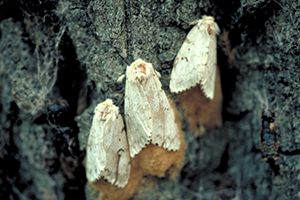Photo Credit: John Ghent, John Ghent, Bugwood.org. Creative Commons Attribution 3.0 United States (CC BY 3.0 US) License; https://creativecommons.org/licenses/by/3.0/us/.
Lymantria dispar
Common Name: spongy moth
Other Common Names: gypsy moth
Animal Guild: Insect
Class > Order > Family: Insecta > Lepidoptera > Erebidae
Where is the species found?
States & Provinces
AB, BC, CT, DE, IA, IL, IN, KY, MA, MD, ME, MI, MN, NB, NC, NH, NJ, NL, NS, NY, OH, ON, PA, PE, RI, TN, VA, VT, WI, WV
Which phenophases should I observe?
Do you see/hear...?
Activity
Adults Lymantria dispar , females are tannish-white and cannot fly, while males are mottled brown and gray and fly in search of females.More...
For abundance, enter the number of individual animals observed in this phenophase.
Reproduction
Mating Lymantria dispar , females are flightless so mating does not occur in flight.
For abundance, enter the number of individual animals observed in this phenophase.
Egg laying Lymantria dispar , eggs may be deposited on tree trunks or other outdoor surfaces.
For abundance, enter the number of individual animals observed in this phenophase.
Eggs Lymantria dispar , eggs are enclosed in a large, teardrop-shaped mass covered with yellowish-tan hairs. Do not include empty egg masses after the caterpillars have chewed their way out of the eggs.
For abundance, enter the number of individual animals observed in this phenophase.
Development
Caterpillars Lymantria dispar , young caterpillars are buff or black in color and covered with tan hairs. Older caterpillars are black with long, tan hairs and have red and blue dots on their back.
For abundance, enter the number of individual animals observed in this phenophase.
Caterpillars feeding Lymantria dispar , caterpillars feed on the leaves of trees, shrubs and other plants.
For abundance, enter the number of individual animals observed in this phenophase.
Pupae Lymantria dispar , pupae are enclosed in a dark brown shell with a few tufts of tan hairs, and are often hidden in cracks, crevices or on the underside of branches or other outdoor surfaces. Do not include empty pupal shells after the adult has emerged from them.
For abundance, enter the number of individual animals observed in this phenophase.
Dead adults For abundance, enter the number of individual animals observed in this phenophase.
Dead caterpillars For abundance, enter the number of individual animals observed in this phenophase.
Method
Individuals at a light For abundance, enter the number of individual animals observed in this phenophase.
Individuals in a net For abundance, enter the number of individual animals observed in this phenophase.
Individuals in a trap For abundance, enter the number of individual animals observed in this phenophase.
What do these phenophases look like?
The following Phenophase Photo Guides for this species have been vetted for accuracy by the USA-NPN National Coordinating Office. Most photo guides are developed for a particular local or regional monitoring effort, and some of the content may not apply to your effort or your region. However, we make them available to provide as much help as they may in illustrating phenophases for this species. If you have high quality phenophase photos that you are willing to share with us, please visit the Phenophase Photo Guidelines page.
Be aware there is variation from individual to individual within a species, especially across different regions, so your plant may not look exactly like the one pictured.
Since they do not always include complete definitions for the species, use these photo guides ONLY in conjunction with the official Nature's Notebook phenophase defintions included in the table above, in the phenophase definition sheet that downloads with the datasheet, or in the Observe screen in the mobile app.
